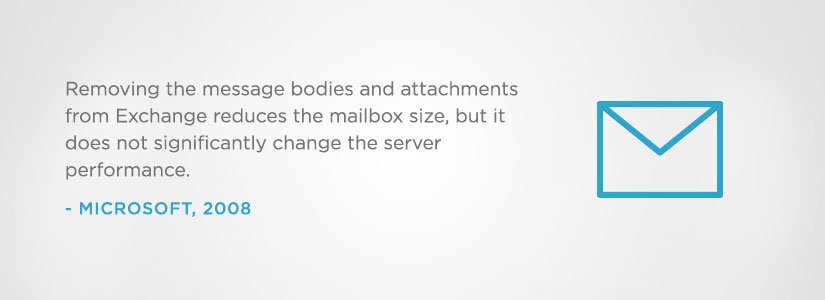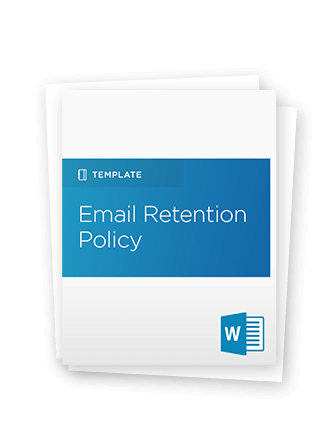Email Stubbing: A Challenging Approach to Archiving

Email archiving solutions are designed with a common purpose: to reduce the load on your mail server without restricting the accessibility of user emails. Stubbing is another method of achieving this.
The theory behind email stubbing is that the emails in question present a low storage requirement, as it would appear the emails are reduced to show only the header information, rather than the full message.
On the surface, it quickly and drastically reduces volume sizes and backup windows without increasing complexity.
A closer look at this archiving method, however, reveals that stubbing actually poses quite a few challenges.
Are you looking for an email archiving solution? Here are the 17 best questions to ask
What is a stub?
A stub file is a computer file that appears to be immediately available for use, but is held in part or entirely on a different external storage repository.
“Stubbing” is a technique of keeping track of archived data once it’s sent from user-based storage to external, or cloud-based, storage. It is a process whereby messaging data is replaced and stored, leaving behind a small copy of the original file on primary storage.
When a stub file is accessed, the device driver software intercepts the request, and points towards the file’s new location. When the user opens the message, the stub file retrieves the archived email and/or attachment from the archive.
This reduces the amount of stale data sitting on your server, whilst maintaining simple user access.
By definition, stubbing is considered a hierarchical storage management concept, meaning it is a technique which automatically moves data between high-cost and low-cost storage platforms.
Types of Stubbing
There are two types of stubbing that message archivers typically provide: Attachments Only, or the Entire Message.
Depending on the option selected, either a fragment of a message or the full email is moved to its own storage database and a hyperlink is created pointing to the original attachment or message.
Attachment-Only Stubbing — If selected, the attached data from the original message is then removed from your server and replaced with the stub file. Any requests to access the file or message will be automatically redirected to, and served from, the message archiver.
A short message containing the names and sizes of the stubbed content is placed in every “stubbed” email, along with a hyperlink from which users can access the attachments.
Entire Message Stubbing — Similarly, the entire message body is replaced with a text excerpt containing a link to the original message. As with the stubbing of attachments, the original message is then removed from your server and replaced with a stub. The requests to access the file or message will be automatically redirected to, and served from, the message archiver, and a hyperlink for access is made available.
The Reality of Stubbing
Stubbing solutions seemingly offer tangible benefits, and initially seem to work like magic. Mailbox sizes initially shrunk and backup windows were quickly reduced. But over time, stubbing also created newer, bigger challenges. These include:
Performance Issues — Customers discovered that even though stubbing solutions reduced mailbox size, they left item counts the same. In other words, mailboxes were being filled with multiple small files. Unfortunately, the amount of mail is not what has the biggest effect on performance; it is the number of items in your mailbox.
Exchange Server Issues — Microsoft Exchange administrators quickly learned that their server maintenance and client performance was just as cumbersome over time as it was before deploying the archiving solution.
After seeing customers initially struggle with stubbing, Microsoft released a TechNet article in 2008, recommending against stubbing and explicitly stating:
“Removing the message bodies and attachments from Exchange reduces the mailbox size, but it does not significantly change the server performance for users accessing Exchange via Outlook in on-line mode and Outlook Web Access. Item counts are the primary performance driver for the Exchange store, and not aggregate size. For example, server performance with a folder containing 100 KB of full e-mail message items is similar to a folder containing 100 KB of stub files. When deployed, these solutions should be configured to move the email content out of the mailbox without retaining stub files in the mailbox.”
This sentiment was backed up in 2010 by Perry Clarke, GM for Exchange Server:
“Now that there are real alternatives, the complexity, fragility, incompleteness and expense of stub solutions should make anyone thinking about deploying them pause and think for a very long time.”
Search Capability Issues — One primarily appealing factor of stubbing solutions is the perception that the new archiving solution will be transparent after implementation.
However, search capabilities are limited through the stubbing process. The bulk of the data being searched has been moved using this process, thus increasing the likelihood of performing a search on the archived data to locate a message or attachment.
Ease of Use Issues — IT departments liked the idea of stubbing because the message appeared to stay in the user’s mailbox. However, since messages were either fully in the mailbox or partially in the mailbox (as stub files), users ended up having to search the mailbox and the archive for any given item.
Mobile Accessibility Issues — Mobile access to data is now a business necessity. An initial promise of stubbing solutions was the ability to allow user access anywhere. However, it was discovered that stub files are not compatible with all mobile devices.
Archive access is offered on some solutions via Microsoft Outlook Web Access. Stubs viewed from some devices will not work because the mobile client lacks a plug-in and cannot interpret the stub.
Legal Ramifications of Stubbing Solutions — Email stubs can contain responsive metadata. User actions (e.g., flagging an email to a stub, prioritizing, categorizing, marking as read or unread, assigning retention policies, moving to another folder, or deleting) add this metadata to the stub that could be relevant to a lawsuit, should such a legal matter present itself.
Ignoring or deleting stubs and their metadata should never be done without fully understanding the legal consequences.
If these stubs are left unassociated with the original archived email in a legally defensible manner, a company could be accused of a failure to make disclosures or to cooperate in discovery.
Advanced Archiving is a Smart Alternative Solution to Email Stubbing
An advanced email archiving solution is capable of capturing, saving and indexing every single email — this includes incoming and outgoing emails, historic emails from the mail server, emails from PST and other archiving solutions.
Contact us today to learn more about our email archiving capabilities.

